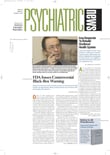Signs of trouble with the State Children's Health Insurance Program (SCHIP), a mainstay of efforts to bring health care to low-income children, began to appear last July (Psychiatric News, September 3).
Reports issued then, which covered the fiscal quarter ending in December 2003, showed a decline in enrollment for the first time since the program began.
The program, enacted as part of the Balanced Budget Act of 1997, helped reduce the national percentage of poor children without insurance from 22.4 percent in 1997 to 15.4 percent in 2003.
A report commissioned by the Kaiser Commission on Medicaid and the Uninsured and released last month describes some of the strategies states are using to curtail enrollment and suggests likely trends in future coverage.
Donna Cohen Ross, lead author of “Beneath the Surface: Barriers Threaten to Slow Progress on Expanding Health Coverage of Children and Families,” and her colleagues at the Center on Budget and Policy Priorities, surveyed state officials concerning actions about SCHIP and Medicaid during the period from April 2003 to July 2004.
They found that 23 states had taken steps to restrict enrollment for eligible children and their parents through those two programs (see chart). Among them:
•
Freezing enrollment for varying periods of time.
•
Instituting methods that increased difficulties in enrollment. Those methods included requiring additional verification of income and age, reinstating face-to-face interviews, and restricting enrollment to certain periods of the year.
•
Increasing premiums or expanding the population required to pay premiums. States began imposing premiums on families just above the federal poverty level, which is $15,670 for a family of three in 2004.
Ross pointed out in the report that the methods of increasing difficulty in enrollment often represented a reversal of policies instituted earlier to simplify and encourage enrollment.
She wrote that beginning in the 1990s, “states placed a high priority on enrolling uninsured, low-income children... in health coverage.”
They increased access to coverage by expanding eligibility and designing streamlined enrollment systems featuring simple mail-in applications, minimal verification requirements, and guaranteed 12-month coverage.
Many states incorporated those changes into their Medicaid program, which helped change its image to a “health insurance program for working families.”
But, because of budget constraints, the emerging trend is to retract procedures that have proved successful in increasing enrollment in the past.
In 2001 only one state had retracted a simplified procedure. By 2004, 11 states had reinstated one or more procedural barriers to coverage.
Ross concluded, “As states dispense with simplified procedures in Medicaid and SCHIP, the progress made on enrollment is in danger of unraveling.”
“Beneath the Surface: Barriers Threaten to Slow Progress on Expanding Health Coverage of Children and Families” is posted online at<www.kff.org/medicaid/7191.cfm>.▪

